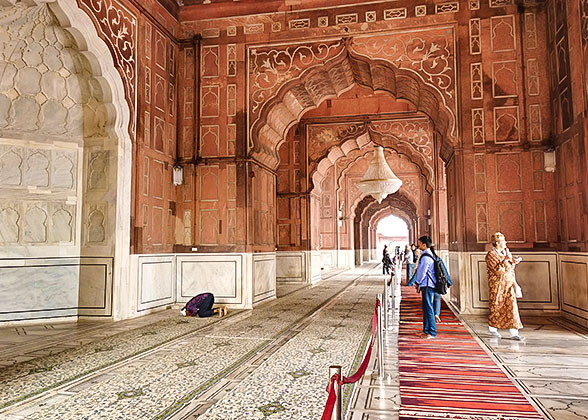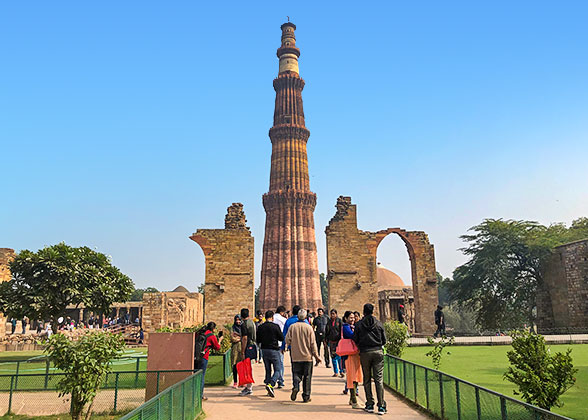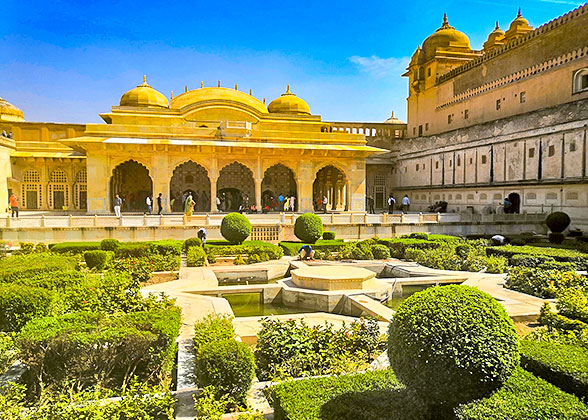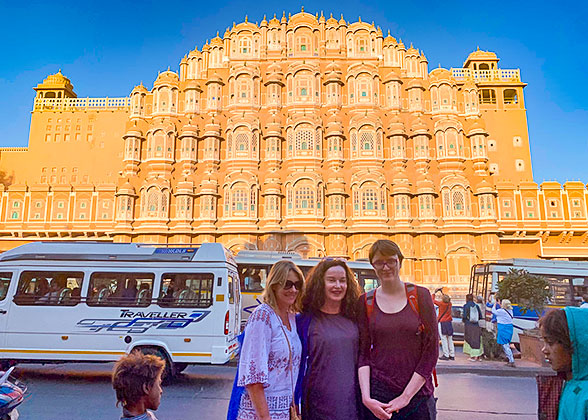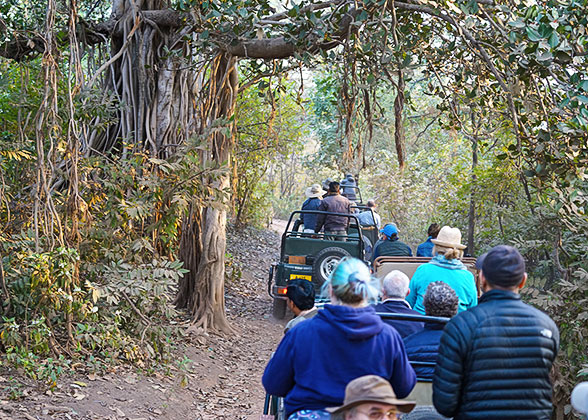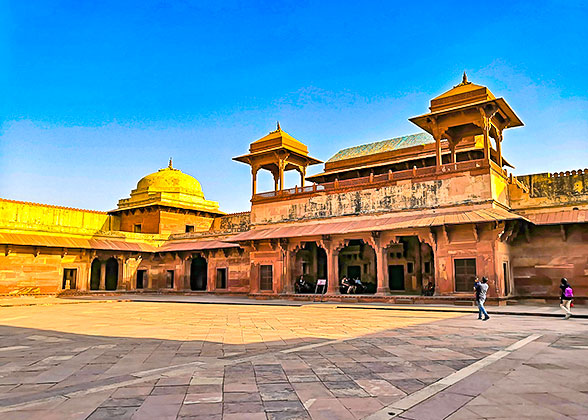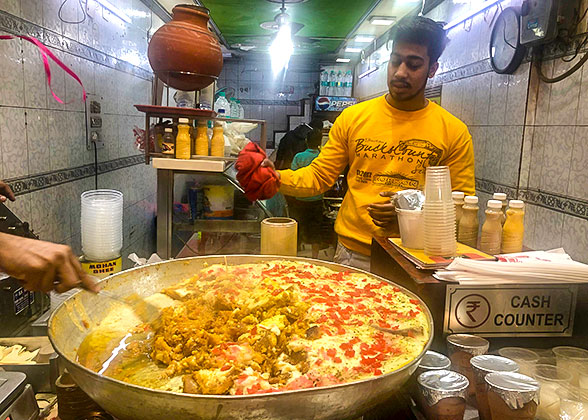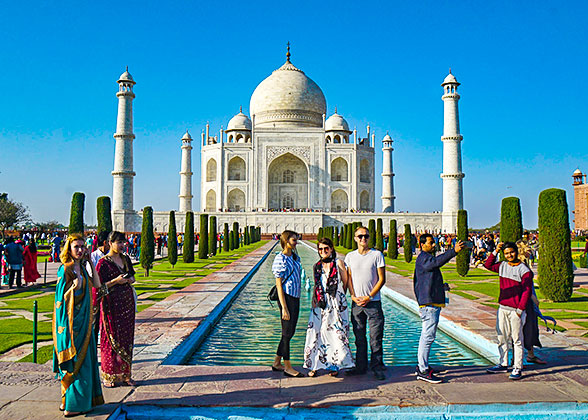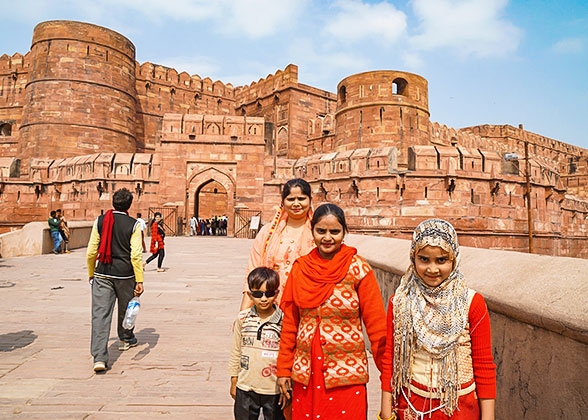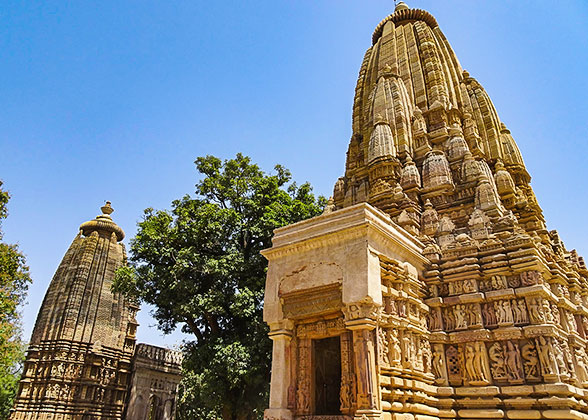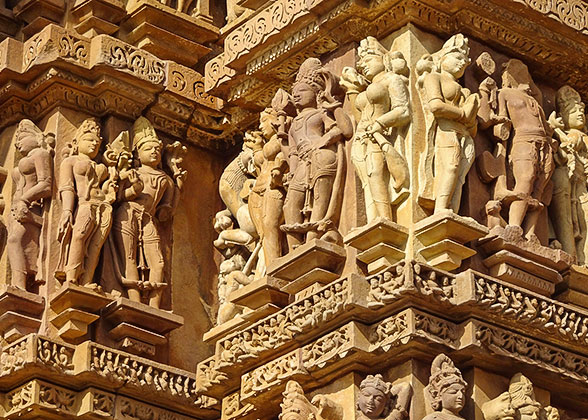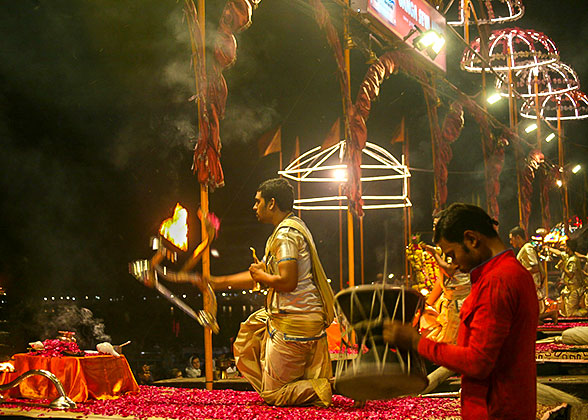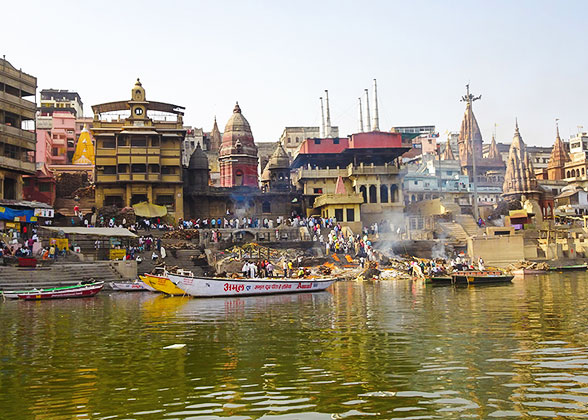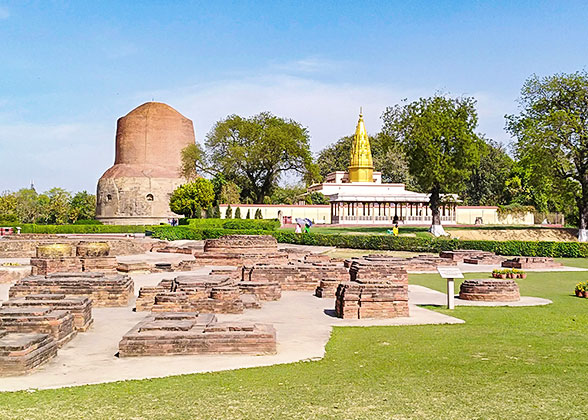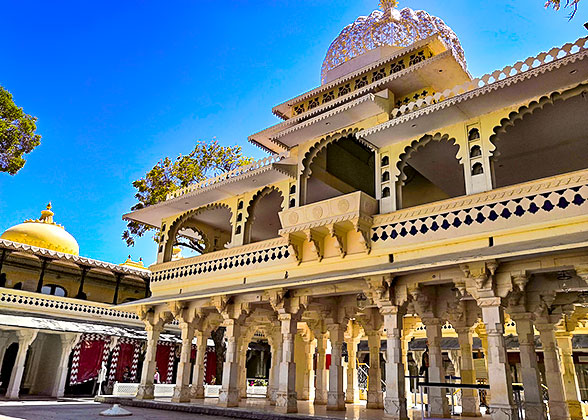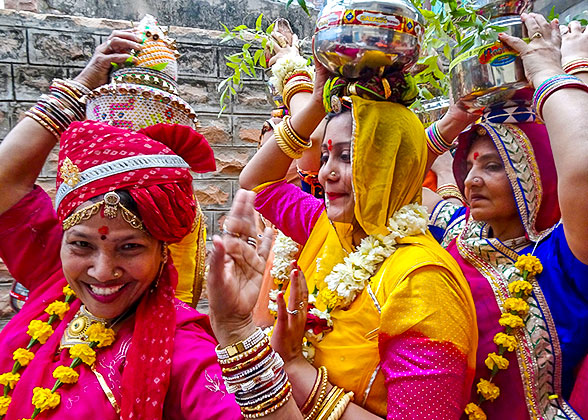Day 1: Arrive in Delhi; Airport Pick-up
Arrival Note: Welcome to Delhi! Upon your landing at the Indira Gandhi International Airport, our representative will be right at the arrival hall waiting for you. You will be led to a well-equipped private car, and our driver will serve you with a comfortable drive to the hotel.
Activities & Dinner Suggestion:
There are no guided sightseeing arrangements today, in view of your jet lag. Our carefully selected 4 and 5-star hotels have excellent facilities and reputation, with restaurants, bars and swimming pools. You can have a relaxing afternoon and evening inside. If you’re not tired, you can explore the city as you like during the rest of the day. The 5-star hotel we choose is close to the Windsor Roundabout Fountain and Vijay Chowk Park, which are good places for walking.
► Tip: Where to Exchange Local Currency
Visa and Master cards are acceptable at large shopping malls, high-end hotels and restaurants, but only cash can be used at small restaurants or shops. We suggest you exchange rupee or take US dollar and Euro cash with you before entry. When you run out of cash during visit, you can withdraw rupees from local ATMs with your card. Moreover, some shops located in the tourist area provide exchange service, our guide can help you with this during the visit. Airport is not an ideal place due to the unfavorable exchange rate.
|
Day 2: Historic Sites in Old & New Delhi
Sightseeing Activities: Our tour of India will begin with a visit to the Raj Ghat, the cremation site and memorial of the great Indian leader Mahatma Gandhi. Next, we will enjoy the iconic red sandstone appearance of the Red Fort (drive pass), once the Mughal imperial residence, to take some pictures from outside, and then the guide will lead you to visit the Jama Masjid, a massive mosque built by the Mughal Emperor Shah Jahan in the 17th century. Stepping out of the mosque, we will immediately enter the busy world of the Chandni Chowk, the capital Delhi’s busiest market with a long history. ★ Travel Different: We will arrange an interesting rickshaw ride for you at the Chandni Chowk to experience the real hustle and bustle of the local life up close. In the afternoon, we will first go to the Gurudwara Bangla Sahib, a Sikh religious site giving a serene experience, and then we’ll explore two important UNESCO World Heritage sites. One is the Humayun's Tomb, the garden-tomb of the Mughal Emperor Humayun with top-notch landscape; while the other is the Qutub Minar, a 73-meter (238-foot) finely carved minaret built in 1193. Our last stop of today will be the India Gate, a giant arch built as a memorial to the Indian soldiers died in the First World War. After the visit, we will drive past the majestic Parliament House and other government buildings and return to the hotel. How to Maintain Gastrointestinal Health during Your Vacation When you arrive in a country, new environment may lead to a decline in the immune system. According to a survey, 20% -40% of travelers in India have experienced diarrhea, so those who travel to India must pay attention on this. But in fact, there is no need to worry too much about this as long as you drink the bottled water and eschew street food. During the journey, our guide and driver will suggest good and hygienic restaurants for you, we always prioritize your health and wonderful experiences. Meals: Breakfast Humayun's Tomb Qutub Minar
|
Day 3: Travel from Delhi to Jaipur by Private Car
Private Transfer to Jaipur: After breakfast, our exclusive car with chauffeur is ready to serve you on the 5 to 6 hours’ journey to Jaipur. Along the way we can stop at some service areas for coffee break, or you can ask the driver to stop if you see a favorite photo spot.
Upon arrival at the hotel in Jaipur, you can have a rest and explore the Pink City on your own. Almost every building in Jaipur’s Old City is painted pink, perfect for taking photos especially at sunset.
Why Is Jaipur a ‘Pink City’?
Almost every building in Jaipur’s Old City is painted pink, perfect for taking photos, especially at sunset. So why is it a pink city? There are many theories.
The one is from the founder of Jaipur, Sawai Jai Singh II, the most important courtier of the Mughal emperor Aurangzeb. He was also a mathematician, an astronomer, and an excellent city planner. To make Jaipur special, Jai Singh imposed "color control" on the city, ordering that all houses in the city be painted pink and that buildings must be built of shallow sandstone. Jaipur was properly planned and built, and it remains one of the most beautiful cities in India even today.
Another theory goes that, all buildings painted pink in the 19th century were to welcome the Prince of Wales, as represents hospitality, hence the name of the city. At present, Jaipur still has the rule that houses facing the street must be painted.
Meals: Breakfast
|
Day 4: Jaipur Highlights: Amber Fort, Maharaja City Palace, Palace of Winds
Sightseeing Activities: In the morning, we’ll first get to the Amber Fort on a hill on the northern outskirts of Jaipur. Accompanied by our guide, you can walk from the car park to the fort entrance, or you can hire a jeep or an elephant for this way. You’ll see that the skillful combination of yellow and pink sandstone as well as white marble reveals the artistry of the ancient Mughal people, while the colossal structures show the majesty of this erstwhile capital. On the way back to downtown Jaipur, we will visit several key sites. After a brief stop at the Jal Mahal to admire the floating palace on the lake, we will head to the Maharaja City Palace, a splendid royal palace known for its rich historical collection. Next, we will visit the Jantar Mantar, which is a collection of 19 stone-built astronomical instruments. After that, we will appreciate the Hawa Mahal, whose unique structure and pink honeycomb-like facade make it an excellent place for photography. At last, we’ll drop by the Birla Temple and return to the hotel. Find Your Own Indian Horoscope at Jantar Mantar. The world’s largest sundial is located in Jantar Mantar in Jaipur. The astronomical observatory has a history of more than 300 years and most of the precise instruments are still available today, showing the amazing wisdom of the ancient Indians. Jantar Mantar was built of marble in 1726-1734, which is another architectural wonder of the founder of Jaipur, Sawai Jai Singh II. Besides the world’s largest sundial, there are also 12 separate buildings, representing 12 constellations. Climb the stairs to the top of the tower, and try to find your own Indian horoscope with the help of your guide. What an interesting experience! Meals: Breakfast
|
Day 5: Adventure in Ranthambore Tiger Reserve
Today, we will set off for the Ranthambore National Park, which is widely known as a wild tiger sanctuary and a brilliant place to experience the Indian wildlife. After 3 to 4 hours’ drive, we will reach our lodging in Ranthambore. After lunch at the hotel, we will take an exciting Gypsy safari in the afternoon to track the tigers. Ranthambore in Brief: It is a large reserve for seeing tigers in their natural habitat. With lush jungles and rich wildlife, the park offers 11 zones for visitors, among which the Zones 1 to 6 are the best, harboring more than 70 tigers, while Zones 7 to 11 with less tigers. It is recommended that you book with us as early as possible so that we can arrange better zones for you to have a greater chance to spot the tigers. In particular, you should avoid visiting the Ranthambore National Park between July 1 and September 30, when the main zones of the park are closed. ★ What makes us different:1. Enough Time: Unlike other travel agencies that cram the sites in your trip in a hurry, leaving only one day or even half a day in this nature reserve, we will give you two days and two nights here, during which you can make three safaris to explore the jungle in depth, have more opportunities to spot the wild animals, and spend two relaxing nights in the comfortable hotel designed to fit right into the nature. 2. Best Vehicle: The park offers two types of safari vehicles – 6-seater Gypsy and 20-seater Canter. Some travel agencies arrange Canter to lower their costs, while we will arrange Gypsy for our guests, with fewer passengers and better experience, and able to give you rides through the rough paths and to some off-road locations. ► Upon your request, we can arrange an exclusive Gypsy that will not be shared by other tourists. If you need, please let us know in advance and pay the difference. Meals: Breakfast, Lunch, Dinner
|
Day 6: Tiger Safari & Jungle Adventure
Today you will enjoy two Gypsy jungle safaris at the Ranthambore National Park in the morning and afternoon. The driver and safari guide, very familiar with the park’s terrain and the animals’ trails, will take you to see the fierce tigers at a safe distance. You can also get close to nature and spot other wildlife during the safari, including the sambar, chital, wild boar, nilgai, spotted deer, uncommon water-birds, marsh crocodile, and python.
Machli - A Bengal Tigress lived in Ranthambore
In the spring of 1997, a Bengal tigress named Machli was born in Ranthambore National Park. She was brave and confident with superior hunting skills, and she even once killed a 12 foot long crocodile, played a crucial role in the regeneration of the tiger population. The documentary titled The Tiger Queen tells the story of Machli's life from her prime to his passing. Its story has been reported by multiple Medias including National Geography, Animal Planet and BBC. You will learn more about Machli and her fellows on how they fought for living and how they survived in the harsh nature. We, as a part of nature, should make great efforts to protect animals, well maintain forests and their living environment.
Meals: Breakfast, Lunch, Dinner
|
Day 7: Drive to Agra; Visit Fatehpur Sikri on the Way
Sightseeing Activities: After breakfast, we will drive to Agra, which takes 5 to 6 hours. On the way, as we approach the western outskirts of Agra, we will visit the Fatehpur Sikri, a UNESCO World Heritage site and once the capital of the Mughal Empire during the 16th century. The guide will take you to admire the iconic entrance Buland Darwaza, the magnificent Jama Masjid, the Tomb of Salim Chishti built for a Sufi saint, and a five-storied palace Panch Mahal. After the visit, we will continue our trip Agra. Why Is Fatehpur Sikri a Fusion of the Christian, Hindu, and Islamic Cultures? Five hundred years ago, Akbar the Great commissioned to build the city Fatehpur Sikri with three kinds of architectural styles. The main reason is Akbar had three major wives and they believe in different religions: Hinduism, Islam, and Christianity. To please his wives, the great emperor just constructed a magnificent city with diverse styles. Roaming around the red sandstone city, you will be amazed at its grandness and gorgeousness. Its lifespan as a capital city is only 14 years, but no doubt it is a world cultural heritage left by Akbar the Great to the world in terms of culture and architecture. ► Tip: Upon arrival at the hotel, we won’t arrange any guided tour for the rest time of the day. You can have a rest, or go out for a walk by yourself. The Tomb of Itimad-Ud-Daulah (Baby Taj) and the Mehtab Bagh (Moonlight Garden) by the Yamuna River are good places to go. Meals: Breakfast Fatehpur Sikri Indian Snack Shop
|
Day 8: Agra Exploration: Taj Mahal, Agra Fort, Local Family Visit
Agra Fort Today we will visit the Taj Mahal early in the morning. Our tour guide will provide an early wake-up call for you, and then we will be the first to enter the Taj Mahal today, watching sunrise at this 17th-century great mausoleum. Built by the Mughal Emperor Shah Jahan for his favorite wife, it is well-known for not only the magnificent Islamic structures, but also the touching love story behind. ★ Local Family Visit and Homemade Lunch: At noon, we will arrange a special lunch for you at a local family. The guide will take you to a real Indian home, where you can talk to the host, learn about the local Indian lifestyle and the education of their children. The housewife will give you a cooking demonstration, and if you are interested, you can learn to make some delicious food for lunch today. Afternoon Sightseeing: We will head to the UNESCO World Heritage site - the Agra Fort, a massive walled city made entirely of red sandstone. Walking through the Agra Fort, built in the 16th century, the guide will show you various ruins and artifacts that witnessed the vicissitudes of the Mughal Empire. Meals: Breakfast, Lunch
|
Day 9: Drive to Gwalior, Visit the Ancient Palaces and Temples
Morning Car Transfer (130 km; 3 hours): After breakfast, our driver will drive you in a private air-conditioned car to Gwalior, a city in Madhya Pradesh of central India, famous for its ancient palaces and temples. Upon arrival, check in at the hotel and take a short rest. Afternoon Sightseeing in Gwalior: The guide will lead you to visit the top attractions in Gwalior, including the Gwalior Fort perching on a sandstone plateau overlooking the city, the Man Mandir Palace, Suraj Kund, and Jal Vilas Palace and Museum. We will end the day at the Tomb of Mohammad Ghaus, where many Muslims and Hindus make pilgrimages in memory of Mohammad Ghaus, a 16th-century Sufi saint and teacher of the Emperor Humayun as well as Tansen, a famous musician at Akbar’s court. Where Is the World’s Oldest Zero?It is interesting to find that the world’s oldest zero, the typical circle symbol is on the walls of an ancient Indian temple in Gwalior. According to archaeologists, the temple was built in 876. The temple's dedication tablets are embedded in the walls of the temple and the circle zero can be found in two different places. One represents the number of wreaths that every day villagers offer to chaturo-bhuja, the temple god, while the other represents the amount of land on which the temple is located. Meals: Breakfast
|
Day 10: Drive from Gwalior to Orchha, a Hidden Gem of Indian Culture
Morning Car Transfer (120 km; 2.5 hours): After breakfast, we will drive from Gwalior to Orchha. Nestled in a forest on the banks of the Betwa River, this ancient town was named Orchha, which literally means ‘hidden place’. Have a rest after checking into the local hotel. Afternoon Sightseeing in Orchha: The guide will show you around the medieval Orchha Ancient Town, still relatively undiscovered and home to ancient temples. We will explore a series of ancient sites along the river, including the Jehangir Mahal, Raja Mahal, and Rai Praveen Mahal. Also, we will witness the architectural marvels of the Chaturbhuj Temple dedicated to Lord Vishnu, and peek into the history by visiting the Royal Chhatris. Legendary Origin of OrchhaOrchha means a mysterious place, first built in 1531, and it once served as the capital city of the Bundela dynasty. About its origin, a legendary goes that a prince in the 11th century planned to sacrifice himself to the goddess of the mountain but she refused since the people needed him more and then he was blessed and named Bundela by the goddess. The prince got the wisdom and built the kingdom of Bundela, which survived for centuries in the midst of its on-off relationship with the powerful Mughal Empire, leaving behind a lot of exquisite castles and forts. Follow our professional guide to discover unexpected surprises along the way. Meals: Breakfast
|
Day 11: Drive from Orchha to Khajuraho, Visit the UNESCO Erotic Sculptures
Morning Car Transfer (190 km; 3 to 4 hours): In the morning, our driver will escort you on a road trip by private car to Khajuraho, an important destination for Hindu culture and the ‘Sex Capital’ of India. After freshening up in the local hotel, we’ll uncover the secrets of the town. Afternoon Sightseeing in Khajuraho: A UNESCO World Heritage site, the small town is famous for the Khajuraho Group of Monuments with incredibly erotic sculptures. There remain more than 20 temples built between 885 and 1000 AD by the Chandela Dynasty, divided into three groups, of which the Western Group of Temples is the most spectacular. Our guide will take you to visit the Western Group to see the unique architectural wonders of Hindu and Jain temples on such a large scale. In addition, you can see sculptures with intricate details on the walls of every temple, blending mythological and sex themes, with lifelike figures, some of which are eye-opening in a variety of surrealist yoga sex poses. You would think that the ancient Indians were so sexually open-minded! However, this is not the case. In India, two such opposite cultural traditions, asceticism and sensualism, coexist so well that you can’t help but marvel at the striking contradiction and union. Finally, we will complete our visit by watching sunset at the Chaunsat Yogini Temple, the oldest Tantric site dedicated to 64 yoginis. Tagore Wrote to Gandhi to Save Khajuraho TemplesThe erotic temples of Khajuraho are the product of Tantfism, which is a branch of Hinduism that promotes religious ideas related to sex. From about 950 to 1050, several kings gathered skilled craftsmen and spent hundreds of years gathering soft yellowish sandstone from 40 kilometers away to build the Khajuraho Temples, with various erotic sculptures according to the Kama Sutra written in around 350. By the 20th century, the temples were facing a risk of destruction. Mahatma Gandhi, the “Father of India”, thought the temples are an abomination and the "obscene and embarrassing" sculptures should be removed. Fortunately, Tagore, the famous Indian poet who held the same high esteem in the minds of the Indian people, stepped forward and promptly wrote a letter to Gandhi, explaining that these sculptures were national treasures and should not be arrogantly destroyed just because some people felt uncomfortable. At last, these precious stone carvings was saved and well preserved. Meals: Breakfast
|
Day 12: Fly from Khajuraho to Varanasi, Sacred Aarti Ceremony in the Evening
Flight to Varanasi: Today our driver will take you to the Khajuraho Airport for a flight to Varanasi. After the one hour flight, you will be greeted at the airport by our representative and escorted on a smooth car transfer to the hotel we have already prepared for you. ★ Special Arrangement of Ganga Aarti: After a good rest in the hotel in the afternoon, our guide will pick you up in the evening and we will go to the Dashashwamedh Ghat by the Ganges River to watch the 1,000-year-old sacred Aarti Ceremony. At sunset, the highly choreographed ceremony takes place on a riverside stage. The devotional worshipers in robes and holding aloft brass lamps march and dance to the chant. You will feel like you’re in the scenes of a mysterious Indian movie. Sadhus at Ghat Ganga Aarti
Varanasi has been settled since 1800 BC and is one of the most important holy sites for approximately 1.2 billion Hindus in the world. In 2019, the Indian Congress Party (BJP) announced a ban on the sale of meat within 250 meters of all temples and heritage sites, which led to a rapid development of vegetarian food. Unlike people in other parts of India who prefer onions and garlic, the strictly vegan sattvic diet prohibits the use of onions and garlic because vegetarian-Hindus believe these spices can increase anger, aggression and anxiety. But many restaurants here also offer meat to tourists and non-vegetarian Hindus. Being here, it is worthwhile and interesting to try the local food. Hereunder we would like to suggest some local restaurants: 1. Kashi Chaat Bhandar, here you can try snack called Tomato chaat. 2. Batti Khokha, the specialty here is a kind of hard and unfermented wheat bread. 3. Baba Lassi & Mix Fruit Juice, try Indian yogurt. The local restaurant and the hotel will also offer these snacks, but it is OK if you want to try when you take a stroll in the city. Meals: Breakfast
|
Day 13: Holy Varanasi: A Boat Tour on Ganges River, Visit to Two Ghats and Sarnath
Sightseeing Activities: In the early morning, we will take a boat tour on the Ganges River, the most sacred water in India. The Hindus believe that the holy river will wash away all the sins. During the cruise, we will pass two ghats, Manikarnika Ghat and the Harishchandra Ghat, where there will be cremation ceremonies. You might be shocked but please stay calm and try to respect and quietly appreciate their traditions. Next, the guide will take you to visit the Kashi Vishwanath Temple, which is nicknamed the Golden Temple because of its gilded top. Then, return to the hotel for breakfast. Afterwards, we’ll drive to the Sarnath, a holy place where the Buddha first taught his Dharma. The guide will show you around the Sarnath Buddhist Temple, Dhamekh Stupa, Sarnath Museum (closed on Friday), and Sarnath Deer Park, and tell you the history and stories of the ruins. Manikarnika Ghat Sarnath Temple
During the special boat tour on the Ganges River, you will see many local people bathing in the water. That’s mainly because the Gange River is considered the holy river in India and Hindus believe that the holy water will wash away all the sins. This belief also comes from a Hindu myth a long time ago. In Hindu mythology, the Gange River is a goddess called Ganga and she is also the only goddess associated with the three important gods of the Hindu trinity (Shiva, Vishnu and Brahma). In some classic sacred literature works of Hinduism like Purana, Ganga is the daughter of King Himawat and Queen Menavati, also the parents of Ganga's sister Parvati, who is Lord Shiva's wife. It is said that Ganga had proposed marriage to Lord Shiva, but Lord Shiva rejected her and accepted only Parvati as his wife. However, he bestowed upon the Ganga a grace divine to the end of the universe, and gave her the power to wash away sin. That’s why you can see so many Hindus strive to bathe in the Gange River praying all the best. Meals: Breakfast
|
Day 14: Fly to Delhi; Connect Your Homeward Flight
Departure Note: Your India tour will end here. We will arrange a private car with chauffeur to transfer you to the Varanasi Airport for a 2-hour flight to Delhi, where you can connect your own-booked flight home or to your next destination. Have a good trip!
Meals: Breakfast
► Please feel free to contact our travel consultants if you want an extension trip to other parts of India or other countries.
|

